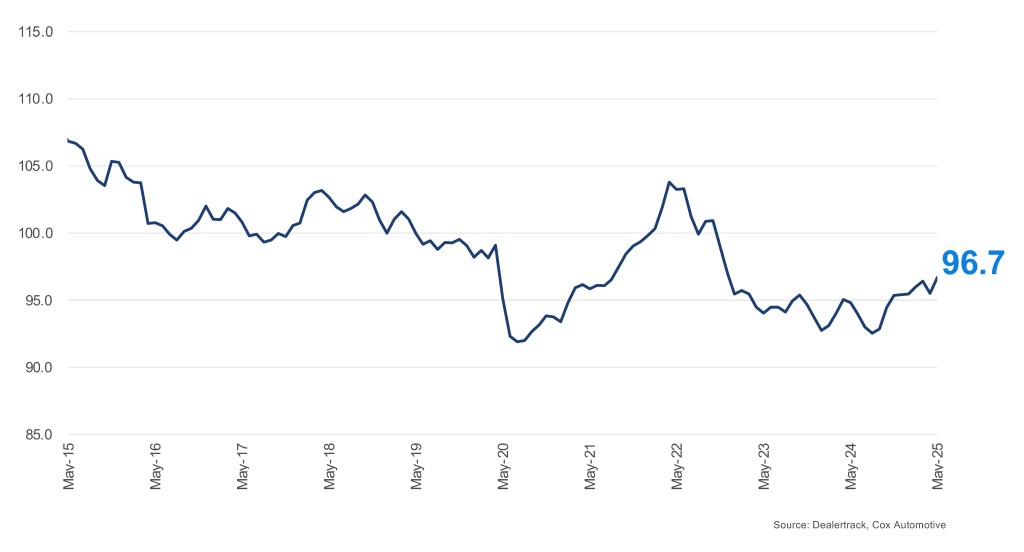Data Point
Auto Credit Access Improves in May
Tuesday June 10, 2025
In May 2025, the Dealertrack Credit Availability Index showed a modest improvement in auto credit access across several key metrics. The All-Loans Index rose to 96.7, up from 95.5 in April, marking a 1.2-point increase month over month and continuing a gradual upward trend in credit availability.
Dealertrack Credit Availability Index
Auto loan access was up in May and up year over year
All Auto Loans Index (Jan 2019 = 100)

Key Drivers of Credit Access
- Approval Rates: The approval rate for auto loans increased by 28 basis points (BPs) in May. This uptick suggests lenders were slightly more willing to approve applications, potentially reflecting confidence in borrower creditworthiness or broader economic stability.
- Subprime Share: The share of loans extended to subprime borrowers rose by 33 BPs, indicating a slight loosening of credit standards for higher-risk consumers. This shift may reflect competitive pressures or a more optimistic view of consumer repayment capacity.
- Yield Spread: The yield spread increased slightly by 5 BPs in May, rising from 7.21% in April to 7.26% in May, based on the difference between the average contract rate and the 5-year Treasury yield. The contract rate rose from 11.12% to 11.28%, while the 5-year Treasury yield increased from 3.91% to 4.02%. This modest widening suggests that lenders passed on some of the rate pressure to borrowers, maintaining their margins despite rising benchmark rates.
- Loan Term Length: The share of loans with terms greater than 72 months increased by 53 BPs. This continued rise suggests that consumers are increasingly opting for longer loan terms to manage monthly payments, even though it results in higher total interest costs over time.
- Negative Equity Share: The proportion of borrowers with negative equity rose by 34 BPs, a potential sign of growing financial strain or vehicle depreciation outpacing loan repayments.
- Down Payment Percentage: The average down payment percentage edged up slightly by 6 BPs, reaching 9.58%. This increase may reflect lender caution or consumer efforts to reduce loan balances.
Channel and Lender Trends
- Channels: Credit access improved across most sales channels in May, with the most notable loosening observed in the used-vehicle segment. New-vehicle loans also saw modest improvement.
- Lender Types: Among lender types, credit unions and banks showed a slight loosening in credit standards, while captives remained relatively stable. Auto-focused finance companies continued to show a cautious approach.
Year-Over-Year Comparison
Compared to May 2024, credit access was looser across most channels and lender types. The most significant year-over-year improvement was seen in non-captive used vehicle loans, while independent used dealers showed the least change. Among lenders, credit unions led the loosening trend, while finance companies remained more conservative.
Implications for Consumers and Lenders
- Consumers: The modest improvement in credit access, especially for subprime borrowers, may provide more opportunities for vehicle financing. However, rising contract rates and longer loan terms suggest consumers should remain cautious and consider the long-term cost of borrowing.
- Lenders: The increase in subprime share and longer loan terms indicates a slightly more aggressive lending posture. However, the rise in negative equity and contract rates suggests that lenders must continue to strike a balance between growth and prudent risk management.
Overall, the May Dealertrack Credit Availability Index reflected a modest loosening in auto credit conditions, shaped by both lender strategy and evolving economic signals. Consumers experienced slightly improved access to financing, particularly among subprime borrowers, while lenders adjusted to rising interest rates and shifting demand with cautious optimism.
The Dealertrack Credit Availability Index tracks six factors that affect auto credit access: loan approval rates, subprime share, yield spreads, loan term length, negative equity and down payments. Reported monthly, the index indicates whether access to auto credit is improving or declining. This typically means that it is cheaper and easier for consumers to obtain a loan or more expensive and harder. The index is published around the 10th of each month.
Jonathan Gregory
Jonathan Gregory is a Senior Manager on Cox Automotive’s economic and industry insights team, which works to find actionable insights for the industry posed by Cox Automotive clients. Jonathan works with the Sales, Finance, and Data Science organizations and creates innovative solutions often combining proprietary data from other Cox Automotive brands. Jonathan joined Cox Automotive in 2022.

